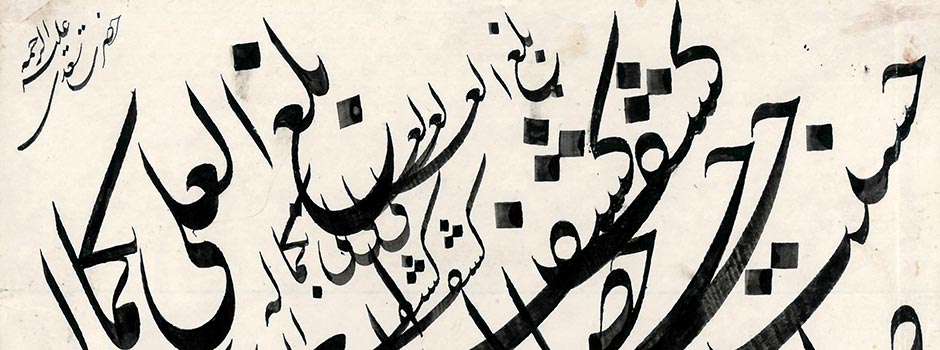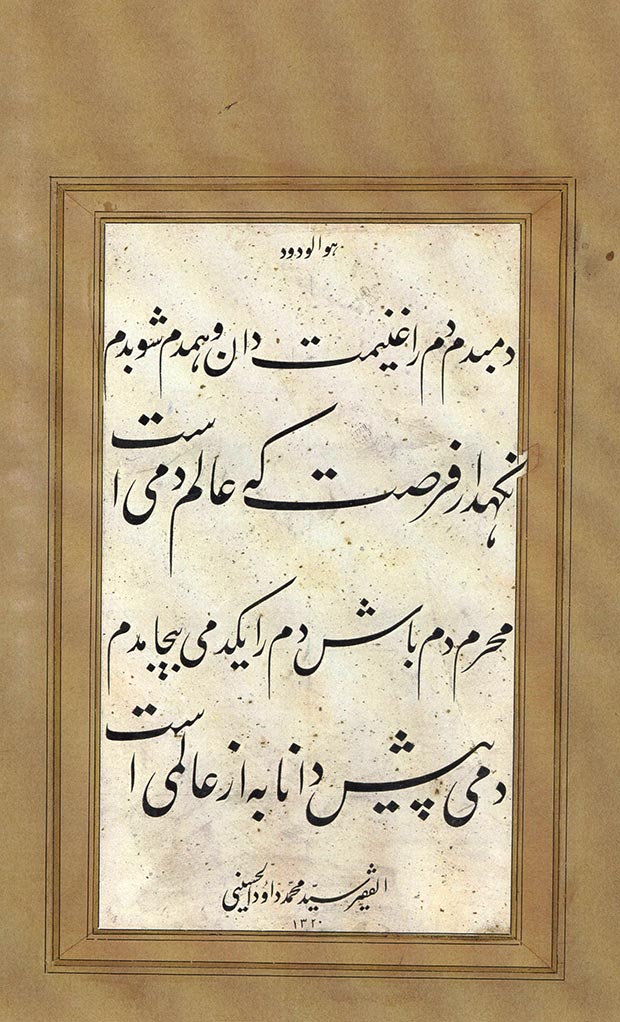
EXHIBITION AT THE PERGAMONMUSEUM, BERLIN (FEB 7 - MAY 3, 2020) Calligrapher to the King – Daud Hossaini
Feb 11, 2020 TRADITION, Calligraphy

Whether microscopic or monumental, the twentieth-century Afghan calligrapher Daud Hossaini (1894-1979) mastered all forms. With exceptional skill and artistry, he inscribed rice grains with multiple Quranic surahs and penned over 550 words in a 2.5 cm square composition. He also designed large scale architectural inscriptions like those that adorn Kabul’s Triumphal Arch (Taq-e Zafar) and other modern monuments. As a cultural advisor to the last Afghan King Muhammad Zahir Khan (r. 1933-1973), Hossaini belonged to the political and intellectual elite in Afghanistan. He held various political positions and oversaw the national printing industry.
Despite his intense political and intellectual career, he remained devoted to his artistic practice and was prolific. Unfortunately, only a fraction of his work survives today. The current location of some 300 calligraphy works owned by the National Archive in Kabul, for example, is not known. Others, gifted by the King Muhammad Zahir Khan to numerous global leaders are either lost or scattered in various archives waiting for discovery and recognition.
-Paper.jpg) Daud Hossaini, Calligraphy on fabric with Abri (Marbled) Paper / © Staatlichen Museen zu Berlin, Museum für Islamische Kunst / Haschmat Hossaini
Daud Hossaini, Calligraphy on fabric with Abri (Marbled) Paper / © Staatlichen Museen zu Berlin, Museum für Islamische Kunst / Haschmat Hossaini
-paper.jpg) Daud Hossaini, Abri (Marbled) Paper / © Staatlichen Museen zu Berlin, Museum für Islamische Kunst / Haschmat Hossaini
Daud Hossaini, Abri (Marbled) Paper / © Staatlichen Museen zu Berlin, Museum für Islamische Kunst / Haschmat Hossaini
The Museum for Islamic Art in Berlin recently acquired a portion of Hossaini’s work with a generous gift and long term loan from Hossaini’s son, Dr. Haschmat Hossaini. The museum presents for the first time a selection of Hossaini’s artistic work with the exhibition Calligrapher to the King, Daud Hossaini. The exhibition, that will be on view until 3 May 2020, aims to shed light on the artistic achievements of Hossaini, who was a modern master working in the long tradition of Islamic calligraphy in Central Asia.
 Daud Hossaini, Calligraphy on paper with gold and silver dots / © Staatlichen Museen zu Berlin, Museum für Islamische Kunst / Haschmat Hossaini
Daud Hossaini, Calligraphy on paper with gold and silver dots / © Staatlichen Museen zu Berlin, Museum für Islamische Kunst / Haschmat Hossaini
.jpg) Daud Hossaini, Arabic four line poetry by Sadi (Persian-poet, 13th-century) / © Staatlichen Museen zu Berlin, Museum für Islamische Kunst / Haschmat Hossaini
Daud Hossaini, Arabic four line poetry by Sadi (Persian-poet, 13th-century) / © Staatlichen Museen zu Berlin, Museum für Islamische Kunst / Haschmat Hossaini
 Daud Hossaini, Siya Mashq / © Staatlichen Museen zu Berlin, Museum für Islamische Kunst / Haschmat Hossaini
Daud Hossaini, Siya Mashq / © Staatlichen Museen zu Berlin, Museum für Islamische Kunst / Haschmat Hossaini
Highlights of the exhibition include the two remaining rice grains with Hossaini’s microscopic calligraphy as well as accompanying letters of thanks and other archival material that praise his artistic skill. Also presented are exceptional examples of Siya Mashq (Black or Pen Practice), a common and highly valued calligraphy form in Central Asia that best illustrates a calligrapher’s capacity to dynamically replicate letterforms and combinations. Practice sheets and marbled or Abri papers also show the visual and material artistry that supports the full range of calligraphy practice as an art form.
Also on view are exceptional calligraphy samples that present both Hossaini’s calligraphic virtuosity and the poetic eloquence of important literary figures including Bidel, Saeb, Hafez, and Sadi. Collectively, the exhibition demonstrates Hossaini’s strong commitment to classical Islamic calligraphy and its connection to the rich cultural history of Central Asia and specifically Afghanistan.
Comments
Add a comment